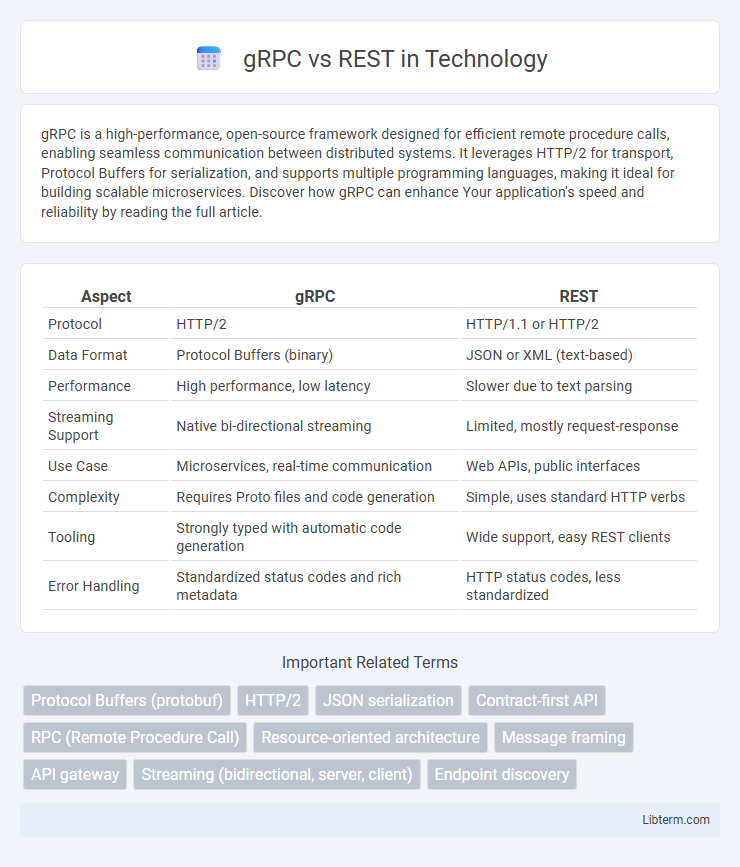gRPC is a high-performance, open-source framework designed for efficient remote procedure calls, enabling seamless communication between distributed systems. It leverages HTTP/2 for transport, Protocol Buffers for serialization, and supports multiple programming languages, making it ideal for building scalable microservices. Discover how gRPC can enhance Your application's speed and reliability by reading the full article.
Table of Comparison
| Aspect | gRPC | REST |
|---|---|---|
| Protocol | HTTP/2 | HTTP/1.1 or HTTP/2 |
| Data Format | Protocol Buffers (binary) | JSON or XML (text-based) |
| Performance | High performance, low latency | Slower due to text parsing |
| Streaming Support | Native bi-directional streaming | Limited, mostly request-response |
| Use Case | Microservices, real-time communication | Web APIs, public interfaces |
| Complexity | Requires Proto files and code generation | Simple, uses standard HTTP verbs |
| Tooling | Strongly typed with automatic code generation | Wide support, easy REST clients |
| Error Handling | Standardized status codes and rich metadata | HTTP status codes, less standardized |
Introduction to gRPC and REST
gRPC is a high-performance open-source RPC framework developed by Google, designed for efficient communication between distributed systems using HTTP/2, protocol buffers, and bi-directional streaming. REST (Representational State Transfer) is an architectural style leveraging standard HTTP methods and status codes to enable stateless, scalable communication in web services, primarily relying on JSON or XML for data exchange. Both gRPC and REST are widely used for building APIs, but gRPC offers advantages in speed and contract-driven development, while REST benefits from simplicity and broad compatibility with web clients.
Core Concepts and Architecture
gRPC uses HTTP/2 for transport, enabling multiplexed streams, binary framing, and built-in flow control, which improves performance and efficiency compared to REST's reliance on HTTP/1.1 and text-based JSON. The core concept of gRPC revolves around defining service methods and message types using Protocol Buffers, providing strongly-typed contracts and seamless code generation for multiple languages. REST architecture centers on stateless communication via standard HTTP verbs (GET, POST, PUT, DELETE) and resources identified by URIs, emphasizing a uniform interface and resource-oriented design.
Data Serialization: Protocol Buffers vs. JSON
gRPC leverages Protocol Buffers for data serialization, offering compact binary encoding that ensures faster transmission and efficient parsing compared to JSON used in REST APIs. Protocol Buffers enable strong typing and schema evolution, reducing payload size and improving performance in microservices communication. JSON, favored for its human-readable format, supports easy debugging and wide compatibility but often results in larger payloads and slower parsing times.
Performance and Efficiency Comparison
gRPC offers superior performance and efficiency compared to REST due to its use of HTTP/2, enabling multiplexed streams, header compression, and binary protocol serialization with Protocol Buffers, which reduces payload size and parsing time. REST relies on HTTP/1.1 with text-based JSON, resulting in higher latency and more bandwidth consumption due to verbose message formats and stateless connections. Consequently, gRPC is ideal for microservices and real-time communication scenarios where low latency and high throughput are critical.
Ease of Development and Tooling
gRPC offers strong advantages in ease of development through its use of Protocol Buffers which enable automatic code generation, reducing boilerplate and improving developer productivity. Extensive tooling support from Google and a growing ecosystem provide debuggers, profilers, and integration with multiple languages, streamlining implementation and maintenance. REST benefits from ubiquitous support across web frameworks and simple HTTP semantics, making it straightforward for developers with existing web expertise but often requires more manual work for schema validation and client generation.
API Design and Evolution
gRPC offers a contract-first API design using Protocol Buffers, enabling strict schema enforcement and efficient binary serialization that facilitates faster communication compared to REST's more flexible, resource-oriented JSON over HTTP model. API evolution is streamlined in gRPC with built-in support for backward and forward compatibility through optional fields and reserved tags, minimizing breaking changes during version upgrades. REST APIs rely heavily on versioning strategies, such as URI versioning or request headers, to handle changes, which can complicate maintenance and lead to inconsistent client behavior.
Security Considerations
gRPC uses HTTP/2 which provides built-in encryption and improved security features like multiplexing and header compression, enhancing protection against common web attacks. REST APIs typically rely on HTTPS for encryption but may require additional measures such as OAuth 2.0 or API keys to ensure robust authentication and authorization. Both gRPC and REST necessitate secure token management and validation to prevent vulnerabilities like token leakage and replay attacks.
Use Cases and Best Scenarios
gRPC excels in low-latency, high-throughput environments such as microservices communication, real-time data streaming, and mobile applications where efficient binary serialization reduces bandwidth usage. REST is ideal for public APIs, web services, and browser-based applications benefiting from its statelessness, human-readable JSON format, and broad compatibility across platforms. Choosing gRPC suits internal, performance-critical systems, while REST fits scenarios prioritizing simplicity, wide client support, and ease of integration.
Limitations and Challenges
gRPC faces limitations such as limited browser support and a steeper learning curve due to its reliance on Protocol Buffers for serialization. REST encounters challenges including stateless communication constraints and less efficient data transfer caused by verbose JSON payloads. Both technologies must address issues related to service versioning and backward compatibility in evolving microservices architectures.
Choosing Between gRPC and REST
Choosing between gRPC and REST depends on factors such as performance requirements, system scalability, and communication protocols. gRPC offers efficient binary serialization with HTTP/2 support, ideal for low-latency, high-throughput microservices and real-time communication. REST provides broader compatibility and easier integration with web clients via HTTP/1.1 and JSON, making it suitable for public APIs and simpler use cases.
gRPC Infographic

 libterm.com
libterm.com